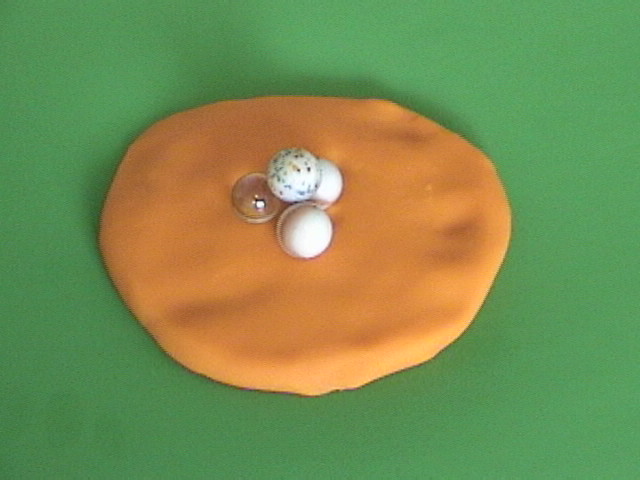
Students work in groups. Each group gets a ball of modeling clay and a bag of marbles. The task is to build a pyramid with a triangular base by stacking the marbles. Marbles have a tendency to roll. So make a flat pancake out of modeling clay, and set the first layer of marbles in it. Then you can build the rest of the pyramid.
Question.
How many marbles would be needed to build the whole pyramid if the side of the base uses n marbles?
Preliminary observation.
----------------------------
Side of the base n: |
Total number of marbles t(n): |
1 |
1 |
2 |
4 |
3 |
10 |
4 |
20 |
5 |
35 |
6 |
56 |
n = 2, t(n)= 4
n = 3, t(n)= 10
n = 4, t(n)= 20

n = 5, t(n)= 35
n = 6, t(n)= 56
The volume of a pyramid is proportional to the number of marbles. Because the volume grows as the cube of the pyramid's linear dimensions (the side of the base, n), we expect that the total number of marbles, t(n), is a third degree polynomial of n:
t(n) = an3 + bn2 + cn + d
If the function t(n) is actually a third degree polynomial whose values are known for the values n = 1, 2, 3, and 4, then therefore we know
t(1) = a + b + c + d
t(2) = 8a + 4b + 2c + d
t(3) = 27a + 9b + 3c + d
t(4) = 64a + 16b + 4c + d
So we have this table:
n = 1 2 3 4
t(n) a+b+c+d 8a+4b+2c+d 27a+9b+3c+d 64a+16b+4c+d
1st differences 7a+3b+c 19a+5b+c 37a+7b+c
2nd differences 12a+2b 18a+2b
3rd difference 6a
Looking at our data from the pyramid,
n = 1 2 3 4
t(n) 1 4 10 20
1st differences 3 6 10
2nd differences 3 4
3rd difference 1
If the algebraic formula t(n) = an3 + bn2 + cn + d describes this table, then we have:
a + b + c + d = 1
12a + 2b = 3
6a = 1
This system of 4 equations in 4 unknowns can easily be solved by sequential substitution.
6a = 1
a = 1/6
Next, 12a + 2b = 3
b = 1/2
Now, 7a + 3b + c = 3
c = 1/3
Finally, a + b + c + d = 1
d = 0
So our polynomial is
t(n) = 1/6n3 + 1/2n2 + 1/3n
So, if t(n) is a polynomial of third degree, then t(20) = 1/6*20^3 + 1/2*20^2 + 1/3*20= 1540
Remark.